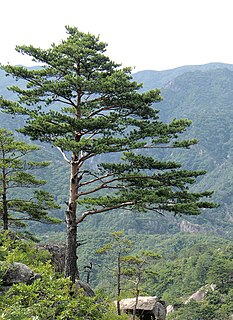
A pine is any conifer in the genus Pinus of the family Pinaceae. Pinus is the sole genus in the subfamily Pinoideae. The Plant List compiled by the Royal Botanic Gardens, Kew and Missouri Botanical Garden accepts 126 species names of pines as current, together with 35 unresolved species and many more synonyms. Pine may also refer to the lumber derived from pine trees; pine is one of the more extensively used types of wood used as lumber.
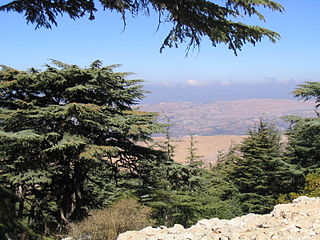
Cedrus, common English name cedar, is a genus of coniferous trees in the plant family Pinaceae. They are native to the mountains of the western Himalayas and the Mediterranean region, occurring at altitudes of 1,500–3,200 m in the Himalayas and 1,000–2,200 m in the Mediterranean.

A spruce is a tree of the genus Picea, a genus of about 35 species of coniferous evergreen trees in the family Pinaceae, found in the northern temperate and boreal (taiga) regions of the Earth. Picea is the sole genus in the subfamily Piceoideae. Spruces are large trees, from about 20–60 m tall when mature, and have whorled branches and conical form. They can be distinguished from other members of the pine family by their needles (leaves), which are four-sided and attached singly to small persistent peg-like structures on the branches, and by their cones, which hang downwards after they are pollinated. The needles are shed when 4–10 years old, leaving the branches rough with the retained pegs. In other similar genera, the branches are fairly smooth.

Firs (Abies) are a genus of 48–56 species of evergreen coniferous trees in the family Pinaceae. They are found through much of North and Central America, Europe, Asia, and North Africa, occurring in mountains over most of the range. Firs are most closely related to the genus Cedrus (cedar). Douglas firs are not true firs, being of the genus Pseudotsuga.

Liriodendron tulipifera—known as the tulip tree, American tulip tree, tulipwood, tuliptree, tulip poplar, whitewood, fiddletree, and yellow-poplar—is the North American representative of the two-species genus Liriodendron, and the tallest eastern hardwood. It is native to eastern North America from Southern Ontario and possibly southern Quebec to Illinois eastward to southwestern Massachusetts and Rhode Island, and south to central Florida and Louisiana. It can grow to more than 50 m (160 ft) in virgin cove forests of the Appalachian Mountains, often with no limbs until it reaches 25–30 m (80–100 ft) in height, making it a very valuable timber tree.
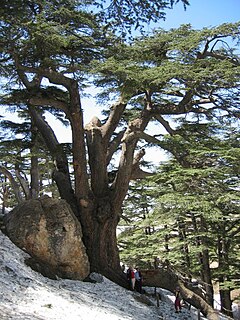
Cedrus libani, the cedar of Lebanon or Lebanese cedar, is a species of tree in the pine family, native to the mountains of the Eastern Mediterranean basin. It is a large evergreen conifer that has great religious and historical significance in the cultures of the Middle East, and is referenced many times in the literature of ancient civilisations. It is the national emblem of Lebanon and is widely used as an ornamental tree in parks and gardens.
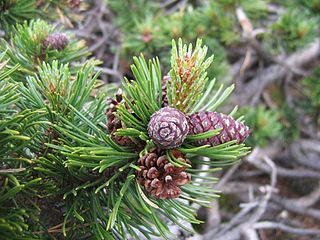
Pinus mugo, known as bog pine, creeping pine, dwarf mountain pine, mugo pine, mountain pine, scrub mountain pine, or Swiss mountain pine, is a species of conifer, native to high elevation habitats from southwestern to Central Europe and Southeast Europe.

The Tortricidae are a family of moths, commonly known as tortrix moths or leafroller moths, in the order Lepidoptera. This large family has over 11,000 species described, and is the sole member of the superfamily Tortricoidea, although the genus Heliocosma is sometimes placed within this superfamily. Many of these are economically important pests. Olethreutidae is a junior synonym. The typical resting posture is with the wings folded back, producing a rather rounded profile.

A conifer cone is an organ on plants in the division Pinophyta (conifers) that contains the reproductive structures. The familiar woody cone is the female cone, which produces seeds. The male cone, which produces pollen, is usually herbaceous and much less conspicuous even at full maturity. The name "cone" derives from Greek konos (pinecone), which also gave name to the geometric cone. The individual plates of a cone are known as scales. The umbo of a conifer cone refers to the first year's growth of a seed scale on the cone, showing up as a protuberance at the end of the two-year-old scale.

Podocarpus is a genus of conifers, the most numerous and widely distributed of the podocarp family, the Podocarpaceae. The name comes from Greek πούς + καρπός. Podocarpus species are evergreen shrubs or trees, usually from 1 to 25 m tall, known to reach 40 m (130 ft) at times. The cones have two to five fused cone scales, which form a fleshy, berry-like, brightly coloured receptacle at maturity. The fleshy cones attract birds, which then eat the cones and disperse the seeds in their droppings. About 97 to 107 species are placed in the genus depending on the circumscription of the species.
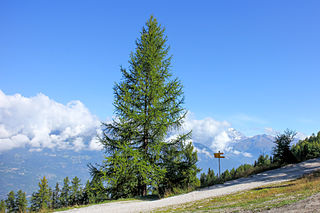
Larix decidua, the European larch, is a species of larch native to the mountains of central Europe, in the Alps and Carpathian Mountains as well as the Pyrenees, with disjunct lowland populations in northern Poland and southern Lithuania. It is widely naturalized in Scandinavia. Its life span has been confirmed to be close to 1000 years but is more often around 200 years. It is claimed that one of the larches planted by the second Duke of Atholl at Dunkeld in 1738 is still standing.

Larix sibirica, the Siberian larch or Russian larch, is a frost-hardy tree native to western Russia, from close to the Finnish border east to the Yenisei valley in central Siberia, where it hybridises with the Dahurian larch L. gmelinii of eastern Siberia; the hybrid is known as Larix × czekanowskii.

Larix gmelinii, the Dahurian larch or Gmelin larch, is a species of larch native to eastern Siberia and adjacent northeastern Mongolia, northeastern China (Heilongjiang), South Korea and North Korea.
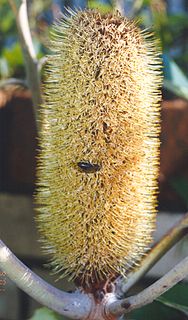
Banksia robur, commonly known as swamp banksia, or less commonly broad-leaved banksia, grows in sand or peaty sand in coastal areas from Cooktown in north Queensland to the Illawarra region on the New South Wales south coast. It is often found in areas which are seasonally inundated.
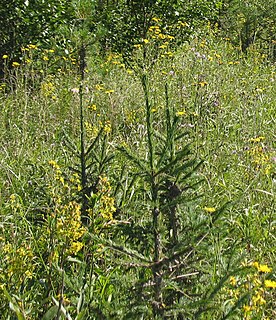
Picea obovata, the Siberian spruce, is a spruce native to Siberia, from the Ural Mountains east to Magadan Oblast, and from the Arctic tree line south to the Altay Mountains in northwestern Mongolia.

Dioryctria sylvestrella, the new pine knot-horn or maritime pine borer, is a moth of the family Pyralidae. It is found in Europe, parts of Asia and North Africa. The adult is a small mottled brown and white insect with a wingspan of 28 to 35 mm. The moth flies in a single generation from June to October and is a pest of maritime pine and several other species of pine, on which the caterpillars feed.

Zeiraphera ratzeburgiana, the spruce bud moth or Ratzeburg tortricid, is a moth of the family Tortricidae. It is found from northern and central Europe to eastern Russia and China. Zeiraphera ratzeburgiana is a taxonomically similar species to Zeiraphera canadensis and can only be distinguished by an anal comb found in Z. canadensis.

Dioryctria amatella, the southern pineconeworm moth, is a species of moth of the family Pyralidae. It is found in the south-eastern United States, from Maryland south to Florida and west into Texas.
Dioryctria cambiicola, the western pine moth, is a species of snout moth in the genus Dioryctria. It was described by Harrison Gray Dyar Jr. in 1914 and is found in North America from British Columbia and Alberta south to California and New Mexico.
Exoteleia burkei, the Monterey pine shoot moth, is a moth of the family Gelechiidae. It is found in North America, where it has been recorded from California.


















